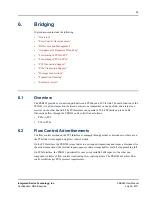
7. PCI Arbitration > PCI Arbitration Scheme
61
PEB383 User Manual
July 25, 2011
Integrated Device Technology, Inc.
Confidential - NDA Required
This is shown conceptually in
. Here the last served high priority device is H1, and the last
served low priority device is L2. When the high priority pointer is at H1, the order of priority is H2, H3,
Low, H-PEB383, H0, and H1.
Figure 19: Arbitration Pointers – Example 1
When the transaction for device 1 is complete, all input requests are sampled to determine which
device should be granted next. If there are no requests the pointer stays at H1, and no grants are given.
If two requests occur at the same time — in this example, L3 and H1 — then L3 is granted and the
pointers advance as shown in
Figure 20: Arbitration Pointers – Example 2
Once L3 is completed, the input requests are sampled again. H0 and H1 are now requesting the bus. H0
would then obtain access to the bus because the new priority ordering is H-PEB383, H0, H1, H2, H3,
L. The initial ordering of the requests is not considered; that is, H1 requested before H0, but H0 wins as
it is first in the priority list. This ensures that all requestors obtain equal access within a priority group.
After asserting the grant, if the bus is in an idle state for
M
clock cycles grant is de-asserted.
H-PEB38x
High Priority
H0
H1
H2
H3
L
L-PEB38x
Low Priority
L0
L1
L2
L3
H-PEB38x
High Priority
H0
H1
H2
H3
L
L-PEB38x
Low Priority
L0
L1
L2
L3






























